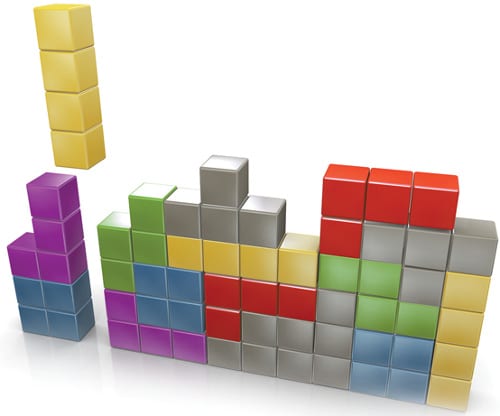Ten games that are available and can be played easily in GNU Emacs are listed and discussed in this article. We start with the most popular one, Tetris.
1. Tetris
Tetris is available in GNU Emacs and you can launch it using M-x tetris. The Up arrow key can be used to spin the tile, while the space key can quickly drop the tile. You can pause the game by pressing the p key. At the end of the game, a score is displayed in a buffer. For example:
112 shakthi shakthi <author@shakthimaan.com> Mon Nov 2 21:12:04 2015 52 shakthi Shakthi Kannan <author@shakthimaan.com> Mon Nov 2 15:24:43 2015 11 shakthi shakthi <author@shakthimaan.com> Mon Nov 2 15:29:39 2015
A screenshot of Tetris in GNU Emacs is shown in Figure 1.
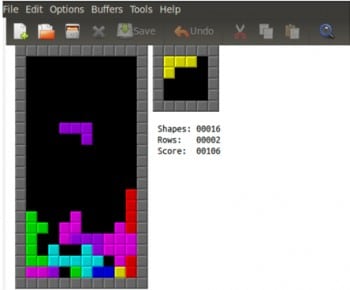
2. Pong
You can play Ping Pong in GNU Emacs with two players, using M-x pong. One player can use the Up and Down arrow keys, and the second player can use the number keys 4 and 6, respectively. Each paddle is represented by three square tiles. If the ball hits the edge of the paddle, it changes its direction. You can use the p key to pause the game. A live score is displayed during the game. A screenshot of Pong is shown in Figure 2.
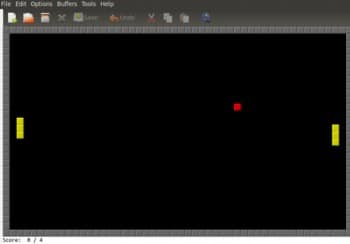
3. Doctor
GNU Emacs comes with a psychotherapist with whom you can chat. Simply type M-x doctor and it will start a session with the therapist. After you type in your statement, you need to hit Enter twice, and the therapist will reply. It will usually ask you another question, and you can continue to chat with the doctor. An example of a session is given below:
I am the psychotherapist. Please, describe your problems. Each time you are finished talking, type RET twice. Hi How do you do? What brings you to see me? I am trying to talk to the doctor. Why do you say you are trying to talk to the doctor? I want to share this transcript with my readers. What makes you believe you might want to share this transcript with your readers? I can, from GNU Emacs, copy this text and paste it in my article Emacs? Hah! I would appreciate it if you would continue. I am looking forward to watching todays cricket match that India is playing. Is it because India is playing that you came to me? Yes, who do you think will win? Earlier you said you would like to share this transcript with your readers? Yes, I am still going to do that. Can you elaborate on that? I am writing a GNU Emacs series for the OSFY magazine. Are you sure? Yes, I have been writing for the past few months. Maybe your life has something to do with this. I want people to learn and use GNU Emacs to improve their productivity. Are you sure about that? Absolutely! Perhaps you could continue.
4. Bubbles
The objective of the Bubbles game is to remove a series of connected bubbles in the fewest number of moves. The game can be started using M-x bubbles. As you move through the grid of bubbles, the connected bubbles with the same colour get highlighted. You can press the space bar to remove them. A screenshot of Bubbles is provided in Figure 3.

5. Conways Life
The shortcut M-x life will start the Conways Game of Life in a new GNU Emacs buffer. The population increases in the course of time, and the generation count is shown in the mode line. A screenshot of the cellular automation running inside GNU Emacs is provided in Figure 4.

6. Morse and NATO conversions
You can convert text to Morse code and vice versa by selecting the text in a buffer and using M-x morse-region. For example, the text morse code gets converted to the following:
--/---/.-./.../. -.-./---/-../.
You can get back the text by selecting the Morse text and applying M-x unmorse-region. Similarly, if you have a word that you would like to spell using the NATO phonetic alphabet, you can use M-x nato-region. To convert it back, you need to use M-x denato-region. For example, the text abc gets converted to:
Alfa-Bravo-Charlie
7. Snake
The Snake game can be started using M-x snake. You can use the arrow keys to move the head. As you play, red boxes appear in the window. If you go over them, the length of the snake increases along with the score. At the end of the game, a summary of the scores is shown. A screenshot of the Snake game is shown in Figure 5.
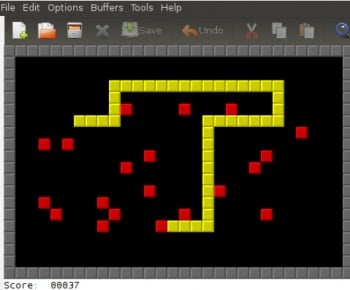
8. Dunnet
Dunnet is a text based adventure game that needs to be started in batch mode as shown below:
$ emacs -batch -l dunnet Dead end You are at a dead end of a dirt road. The road goes to the east. In the distance you can see that it will eventually fork off. The trees here are very tall royal palms, and they are spaced equidistant from each other. There is a shovel here.
The help command gives you the context of the game:
>help Welcome to dunnet (2.01), by Ron Schnell (ronnie@driver-aces.com). Here is some useful information (read carefully because there are one or more clues in here): - If you have a key that can open a door, you do not need to explicitly open it. You may just use in or walk in the direction of the door. - If you have a lamp, it is always lit. - You will not get any points until you manage to get treasures to a certain place. Simply finding the treasures is not good enough. There is more than one way to get a treasure to the special place. It is also important that the objects get to the special place *unharmed* and *untarnished*. You can tell if you have successfully transported the object by looking at your score, as it changes immediately. Note that an object can become harmed even after you have received points for it. If this happens, your score will decrease, and in many cases you can never get credit for it again. - You can save your game with the save command, and restore it with the restore command. - There are no limits on lengths of object names. - Directions are: north, south, east, west, northeast, southeast, northwest, southwest, up, down, in, out. - These can be abbreviated: n, s, e, w, ne, se, nw, sw, u, d, in, out. - If you go down a hole in the floor without an aid such as a ladder, you probably wont be able to get back up the way you came, if at all. - To run this game in batch mode (no Emacs window), use: emacs -batch -l dunnet NOTE: This game *should* be run in batch mode! If you have questions or comments, please contact ronnie@driver-aces.com My home page is http://www.driver-aces.com/ronnie.html
You can then give directions and proceed with the game. An example of a session is shown below:
>n You cant go that way. >s You cant go that way. >e E/W Dirt road You are on the continuation of a dirt road. There are more trees on both sides of you. The road continues to the east and west. There is a large boulder here. >in You cant go that way. >w Dead end There is a shovel here. >d You cant go that way. >e E/W Dirt road There is a large boulder here. >n s e You cant go that way. >in You cant go that way. >e Fork You are at a fork of two passages, one to the northeast, and one to the southeast. The ground here seems very soft. You can also go back west. >w E/W Dirt road There is a large boulder here.
You can exit the game by typing quit at the prompt (>).
9. Gomoku
Gomoku is a strategy board game for which you need to get five pieces in a row (any direction) to win. You and the computer will take turns to play the game. You need to use the Enter key to mark your cross in a position, and the computer will mark its position with a circle. The game ends when either player gets five continuous pieces. A screenshot is shown in Figure 6.
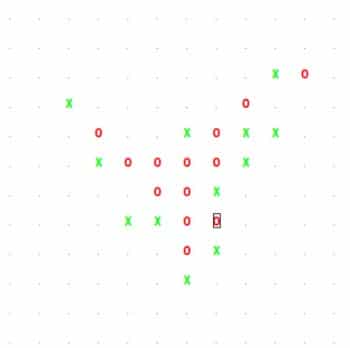
10. Le Solitaire
Le Solitaire is a strategy game that consists of stones represented by o and holes represented by . (a dot). The objective of the game is to remove all the stones except the last one. You can jump over another stone to create a hole. You can use the Shift key with the arrow keys to move a stone. A screenshot of the game in progress is shown in Figure 7.

All the games and examples were tried on GNU Emacs 24.5.1.





























































